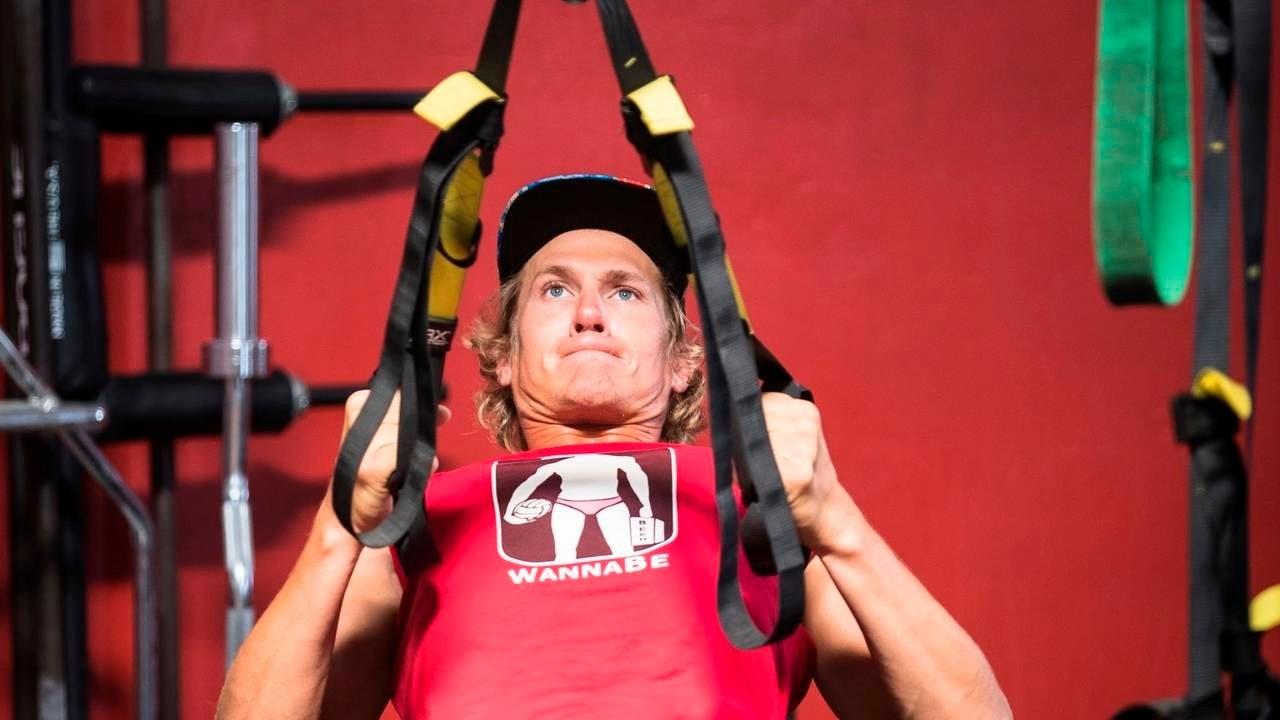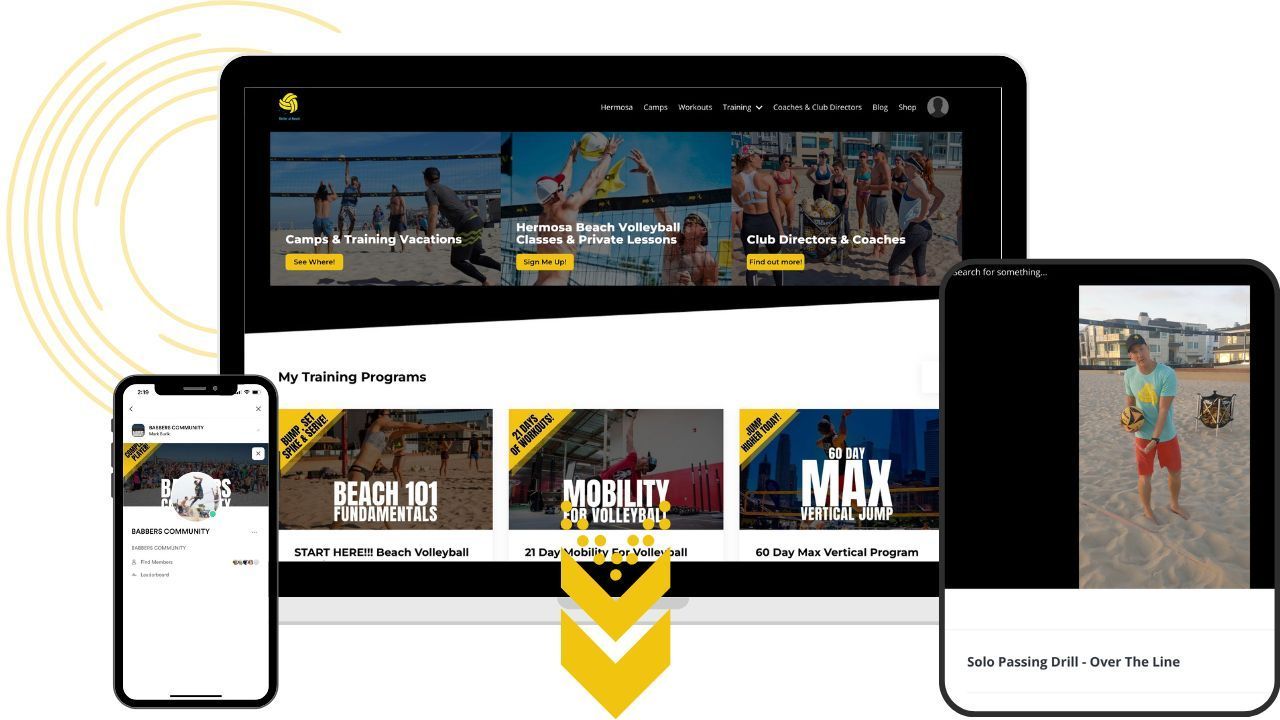
Why upper body strength is still vital for beach volleyball players
We also run beach volleyball classes, private lessons and training camps for adults and juniors in Hermosa Beach, CA and Salt Lake City, Utah. We run volleyball vacations in exotic locations around the world. We can even run beach volleyball clinics for your group, club or team in your hometown! Send an email to [email protected]
A sound beach volleyball training program has to cover all of the bases, but one of the most talked-about topics is how much upper body training is really necessary for a volleyball player.
I remember in 2008, I was watching the USA men's indoor volleyball team in the Olympics with my brother. I had just finished my career at George Mason University and I was a pretty typical college male jock. I was bench pressing and doing biceps curls on a regular basis and while I told myself and everyone else it was because I was looking for high performance, it was probably just for aesthetics. Still, as a volleyball player, I was lean compared to, let's say, a football player. Anyway, while watching the Olympics, my brother said, “I remember when volleyball players were just bean poles but these guys look jacked and ripped.”
I don't know why, but I took some pride when he said that because I said “Yeah man. Volleyball players are real athletes. They need bodies that can last long seasons of unloading on spikes."
As far as sports bodies go, both beach volleyball and indoor volleyball athletes definitely fall into the longer and thinner categories but that doesn't mean that we are the beanpoles we once were.
An upper body strength program is crucial to a volleyball player's long term success but the exercises, sets, reps and speed have to be appropriate for our sport and our goals. We don’t need to move 300 pound defensive linemen so we do not need to bench press 300 pounds! The amount of hours dedicated to this type of strength training would take away from the volleyball specific exercises that give you ten times more bang for your buck when it comes to training for victories on the court.
If human beings had unlimited time energy and recovery ability then as volleyball players we would train to be monsters. There would be no limit to our explosiveness and our strength so we can train it all.
However, we do have limits. Our joints can only handle so much. The more mass we put on, the more impact goes into our joints every time we land. It takes us a while to recover and you need to be fresh for practice. If you're too tired from the gym to do your best during actual volleyball drills, it won't matter how strong you are. You won't be able to pass or side out. It would be tough to win a beach volleyball match, much less a beach volleyball tournament.
Want to show your support and help us make more content? Buy a cool beach volleyball
 |
 |
|---|---|
| Baby Premium Onesie | Ueasy Vertical Jumping Trainer Jump Resistance Bands System Horizontal Leaping Fitness |
Most elite level beach volleyball players lift four times a week in the off-season and somewhere between one and three times a week during season depending on how tired they are and what their tournament schedule looks like. We need time to recover both from lifting and from practice. So when we choose the right exercises for beach volleyball, you have to be specific because we can't spend six hours a day, every day in the gym.
Volleyball players need to move quickly on the ground for very short distances. We also need to explode with a huge vertical jump for blocking and spiking. Lastly, we need to be able to attack with significant velocity and precision. While you can argue with me that every muscle has some role during some part of those three things, there are certain muscles that are limited at best. Your biceps and chest have no need for strength or mass in beach volleyball or indoor volleyball but they do have to support the muscles that are taking on the brunt of the work around them. The muscles that are doing the real work are as follows.
Your legs and your butt have to be strong and they have to be fast so that you can jump, block and spike.
The muscles in your core happily support all of your movement and hold you stable through take off, stretch in the air and snap back in order to detonate on a ball. The muscles in your rotator cuff and the rest of the supporters around your shoulder have to be loose fast and strong in order to hit the hardest spikes. There might be some tricep engagement that you can work on but it's not going to have a mass effect on your velocity. Two muscle groups that we have not mentioned are the pecs and the biceps. If you walk into any Elite Volleyball training gym in the world I can guarantee you that chest and bicep exercises compose less than 5% of their training program.
That being said, your upper body does need to be strong enough to survive long seasons and put continued whip on the ball. If you don't have strong muscles to support your stabilizer muscles in your rotator cuff then all of the force from every swing is going to be felt across that joint. To an extent, thicker stronger arms can help your shoulder be healthier over time because the ball feels lighter. Once you reach a level where your shoulder is supported though, you don't need strength or mass beyond that point.
If you are training for beach volleyball or indoor volleyball you should include some upper body training but It should focus on your back, your shoulders, and specifically your rotator cuffs. A great all around exercise is the basic pull-up. In the training video below from our 60 Day Beach Volleyball Pre-Season Workout Program, we show a few variations that you can do even if you aren't strong enough for a pull-up yet.
Exercises that train these will give you the best bang for your buck and will save you from injuries. Get some rotator cuff exercises before every ball session, train the muscles in your back once or twice a week and add some of the tertiary exercises like triceps and deltoids a maximum of once a week. Overhead triceps extensions simulate the arm motion we need for a volleyball swing and they promotion range of motion in your shoulders and chest. Give these a try!
My personal recommendation is to avoid the bench press but if you need to work on those pecs, start with some explosive push ups or medicine ball launches.
Don't put any unnecessary strain or stress on your shoulders. It is easy to do a bench press improperly and suffer an impingement injury in your shoulder. It's not worth getting hurt doing chest exercises because that move was not going to win you more points anyway!
We're not here to look good, or win the bench press contest.
We're here to win a beach volleyball tournament.
You may also enjoy:
- Shoulder exercises to help every beach volleyball player hit harder
- Core exercises for beach volleyball players
- Mobility and stretches for beach volleyball players
***
Join our email list and Get your FREE Drill Book > www.betteratbeach.com/freebeachvolleyballdrillbook
Want a sample of our programs? Give our Completely Free 3 Workouts for an Increased Vertical Jump a try.
If you want to increase your vertical in beach volleyball to jump higher, hit harder, and win tournaments. All you have to do is sign up for our Beach Volleyball Mastery. We'll help you build a great foundation that lets you add strength without putting on unnecessary size. We'll also equip you with all of the fitness knowledge and programming you need for everything volleyball.
Once inside the membership, you’ll be able to unlock our 60 Day At-Home Max Vertical Jump Training Program along with 9 more skill courses.
Once you sign up, you'll be able to watch the in-depth tutorials, film your “before” videos, start and film your at-home drills and begin posting to our Private Facebook Group. Then, our coaches will break down your mechanics and positioning at our weekly online meetings. Yes, that means we look at YOUR videos and we coach YOU!
Facebook Group CTA VolleyChat! Get Better at Beach Volleyball for posts about common questions/ problems > https://www.facebook.com/groups/betteratbeach
SIGN UP NOW AND LEARN HOW TO WIN FROM THE PROS.





